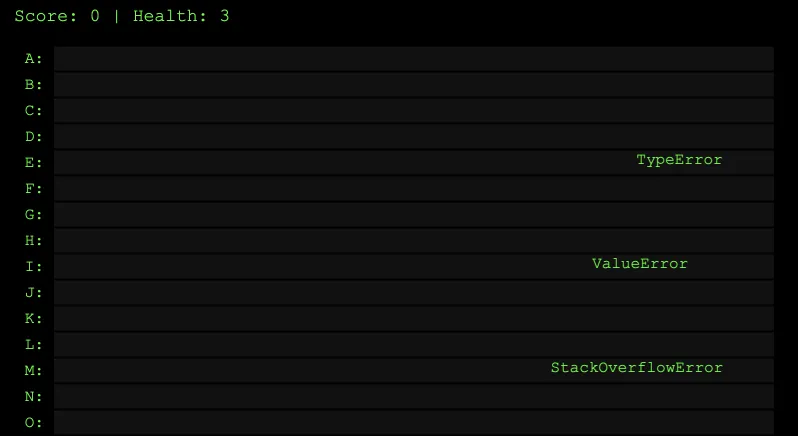
Tech Debt is a keyboard-driven web game that teleports you back to the 90s. Your mission: release a bug-free programming language in one day.
Your boss hired you to fix the mess left by the previous programmer before the ‘95 WEBFEST conference. The conference starts tomorrow morning, and you have a full day (Sunday, unfortunately) to get it done.
How to play
Mechanics are simple: when an error flashes on lane A:, hit A; if
it’s on lane M:, hit M, and so on. Every level teems with buggy
lines, so speed and accuracy are key.
Fix (aka shoot) a bug, and it counts as fixed. Shoot when there’s no bug, and you’ve introduced one. Let a bug reach a label unfixed, and it’s counted as slipped.
You want to be as accurate as possible, and not let bugs slip through. That said, if you miss some, the game will still advance to the next level. It’s not the end of the world, but it will impact your final score.
How the game works
The game includes 13 levels, with a final boss on the last one. At each level, your boss briefs you through a short narrative (sometimes hinting at what bugs to expect).

Bugs spawn randomly in waves. Some levels feature multiple massive waves — special events that unleash an unusual number of bugs in a short amount of time.
Difficulty ramps up with each level: the early ones are slow-paced and easy, while the later stages demand lightning-fast accuracy.

At the end of each level, you’ll see statistics: bugs fixed, bugs slipped, and new bugs introduced.

These stats contribute to your final assessment. After the last level, your boss evaluates your programming language and decides whether to keep you on or fire you.
Why I built it
Don’t get me wrong — I don’t love errors. But I do love tools that help programmers ship better software. My main product is a self-hosted error tracker, and I wanted a fun way to promote it.
A bug encyclopedia felt too boring. I’ve seen that before, and it didn’t gain much traction. I wanted something original and engaging.
I love computer games and always wanted to make one, but a full-scale game demands an insurmountable willpower and time — resources I couldn’t spare for a project with no revenue potential.
So instead, I chose to build a small, focused game that could be made quickly yet still deliver value and fun. This way, I could combine my passion for games with my goal of helping developers improve their software :P
Inspiration and early prototype
The idea for Tech Debt came a few months ago. I spun up Grok and asked if anything like it existed. When Grok said it hadn’t, I knew I was onto something.

Grok produced a rough demo (call it version 0.0.1) even though it was a bad artifact, it proved the concept.

A month later, I began building the real game. I quickly realized I could borrow some ideas from Plants vs Zombies (a timeless classic) because its lane mechanics were very similar.
That’s where the idea for huge wave announcements came from (in Tech Debt, they’re called testing phases).
Why I vibe-coded it
I use AI-aided programming daily, but I’d never truly vibe-coded. To form a clear opinion, I had to experience it firsthand. So I decided to vibe-code this game entirely from scratch.
I love simplicity, and in the era of AI, I don’t understand our reliance on bloated frameworks. Tech Debt was was coded entirely in pure HTML, CSS, and JavaScript. It just works (no build process required) and I’m not limited by any frameworks or libraries.
How I was doing it
I used kamal-skiff to deploy it. This is my go-to stack for building static sites.
For vibe coding, I mostly used Grok, with one or two ventures into Claude and a few more into ChatGPT. VSCode is my editor of choice. I have Copilot installed, but I didn’t use it at all for this project.
I didn’t use Cursor or Windsurf. They just haven’t dinged with me yet. For now, I think I still prefer the old-fashioned (2022? lol) approach: talk to an LLM in its own UI, then copy-paste the relevant bits.
How did it go
To fast-forward: it was addictive, but not without caveats. My main problems with vibe coding:
-
I don’t truly own the code. Vibe coding can get you far, but the moment you commit those first AI‑generated changes, you’re on a journey into the unknown. The more code you add, the less you understand. Luckily, I’m fluent in raw JavaScript, so I could always drop into old‑fashioned code reading, but the incentive to do so is pretty low (AI makes you lazy).
-
Refactoring is necessary. AI doesn’t produce perfect code (and neither do I). With the right prompts you can massage it into shape, but once my codebase grew, I had to ask for a refactor. What started as procedural spaghetti got a lot more readable (and yes, I split things into multiple files by hand, since the AI never suggested it).
-
AI is slow at printing. I leaned heavily on Grok’s “Think” mode, which isn’t the speediest. Asking it to dump an entire file (over 1,000 lines!) so I could copy‑paste in one go meant a single change sometimes took 5–7 minutes of waiting.
-
Copying small bits of code can be challenging. When an LLM suggests a snippet, finding exactly where it belongs can be a pain. That’s why I kept asking for full‑file prints. While I was writing this, I realized what I really needed was a git diff I could apply automatically.
-
AI is terrible at programmatic music. I asked it to compose a soundtrack in Tone.js. Instead of music, I got… well, farts. So I ended up doing the audio by hand.
-
Removing and adding comments all the time is annoying. LLMs love to sprinkle in random comments, and then strip them back out on the next pass. Nuff said.
-
AI is dumb. “Thinking” in LLMs doesn’t exist yet. It can only remix what it’s seen before, it won’t invent the core idea for your game. Sure, it can write code, but you still need to know what you actually want to build.
The upside
However, vibe coding, as demonstrated by my project, is real. It’s not a gimmick, and you should fear for your job. AI is dumb, but in smart hands, it’s a dangerous weapon. You can really do things with it. So my recommendation is to try and get your feet wet to see what you’re missing. It can’t solve all the problems, but it can automate mundane tasks reasonably well.
Conclusion
I’m really happy with how the game turned out. In my opinion, it came out brilliantly well. There are a few rough edges, but they don’t affect the gameplay, and honestly, I don’t care enough to fix them.
Time to pay your tech debt!
P.S. The game has an easter egg.
